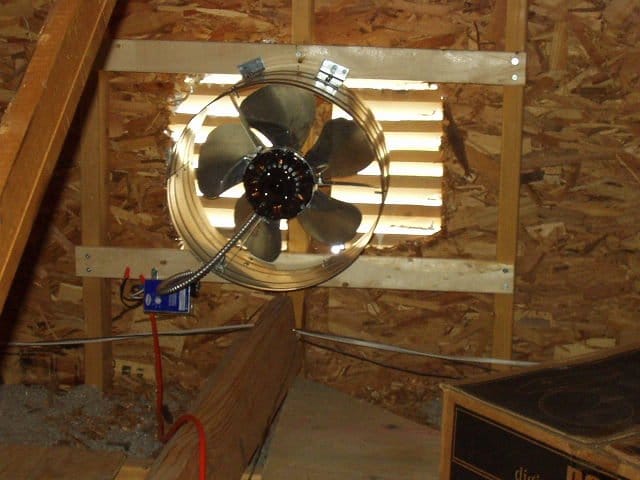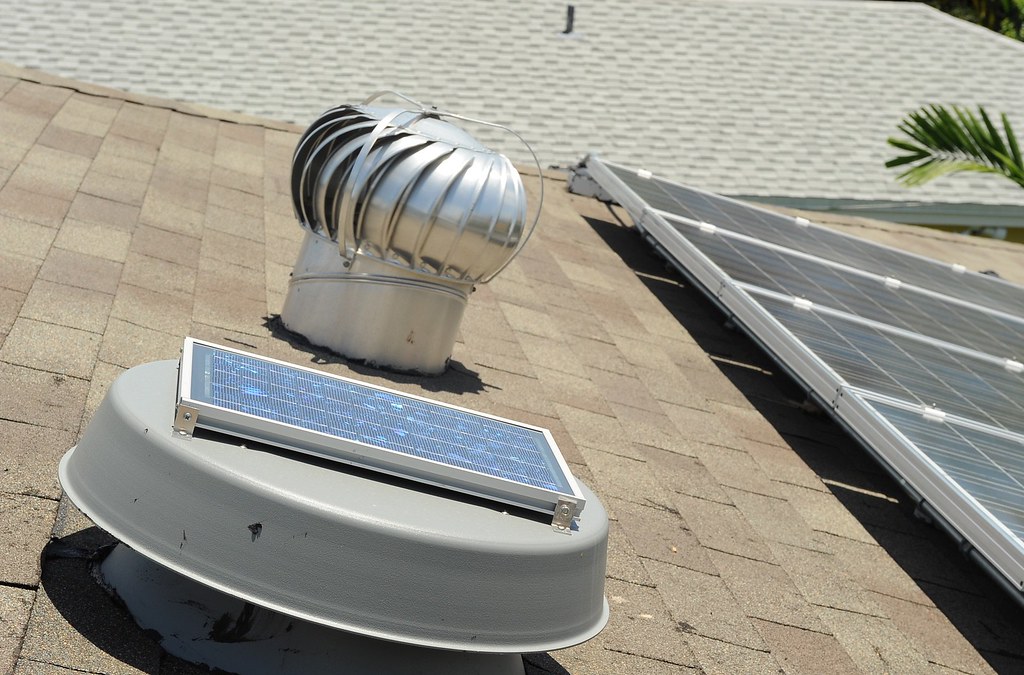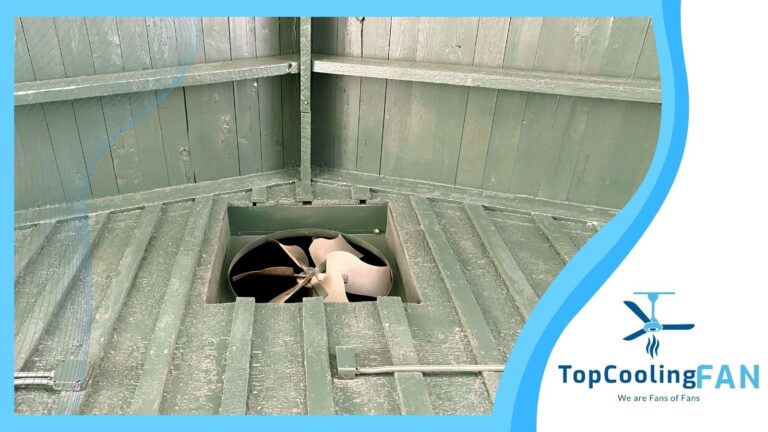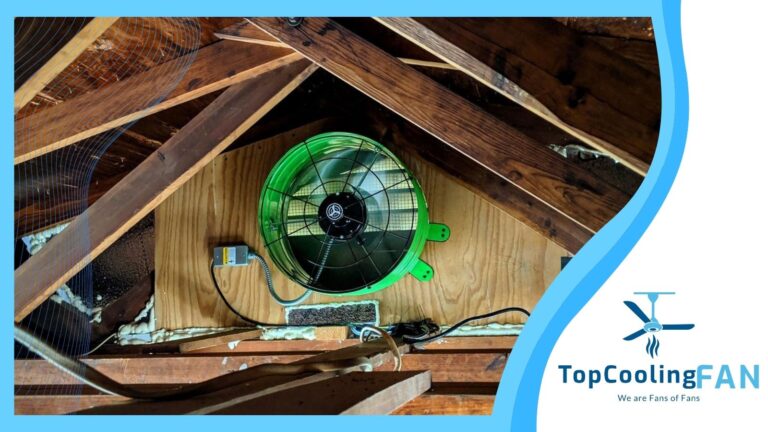How to Use an Attic Fan: Simple Steps for Efficient Home Cooling
Attic fans play a crucial role in maintaining a comfortable and energy-efficient home. By improving attic ventilation, they help regulate the temperature inside the house during those sweltering summer months. They can also be beneficial during winter.

Understanding the mechanics of attic fans is key to optimizing their performance. These fans are designed to expel hot air from the attic space, thereby lowering the overall temperature of the attic.
As a result, they reduce the burden on the home’s cooling system. In conjunction with adequate intake vents, attic fans ensure a steady stream of outside air is moving through the attic. This not only helps control temperature, but also manages humidity levels.
Proper sizing and installation are also essential. An attic fan must be matched to the size of the attic to be effective. Too small, and it will not sufficiently cool the space; too large, and it may create negative pressure issues that can affect the rest of the home.
A well-sized attic fan, when used correctly, can create a more pleasant living environment. It can also extend the life of roofing materials by reducing excessive heat and moisture.
Benefits of Using an Attic Fan
Implementing an attic fan can offer homeowners a multitude of advantages from reducing energy consumption to mitigating moisture-related damage. Particularly in areas that experience high temperatures or humidity levels, an attic fan can be a vital component to maintain a home’s structural integrity and comfort.
Energy Efficiency and Savings
Attic fans, especially models like electric attic fans and solar-powered attic fans, play an integral role in lowering a home’s temperature. This can directly translate to energy savings as there is less reliance on air conditioning systems to combat the excessive heat that rises and accumulates in the attic.
In the long term, homeowners can notice a significant reduction in their cooling costs. Some estimates indicate that proper usage of attic fans can cut air conditioning use by up to 30%.
Improving Air Quality
The function of an attic fan extends to maintaining the air quality within a home. By expelling stale air and facilitating the flow of fresh air, these fans help to reduce concentrations of allergens and pollutants.
For families concerned about indoor air quality, incorporating an attic fan can be a step towards ensuring that the air they breathe is cleaner and healthier, enhancing overall comfort.
Preventing Moisture and Heat Damage
By regulating attic temperature and humidity levels, attic fans help to guard against moisture buildup that can lead to mold growth and mildew. Moisture in excess can cause structural damage, warp wood framing, and deteriorate insulation.
Additionally, in winter, an attic fan can help prevent ice dams, which put stress on roof shingles. Proper air circulation diminishes these risks and contributes to the durability of the home structure.
Understanding Attic Fan Types
When selecting an attic fan, it’s essential to understand the differences between fan types, their power sources, and installation methods to ensure optimal energy efficiency and ventilation.
Solar-Powered Versus Electric Fans
Solar-powered attic fans operate using solar energy, making them an eco-friendly option that can reduce electricity costs.
They are designed to work during the day, especially when the sun is at its peak, to effectively vent hot air out of the attic. On the other hand, electric attic fans require electrical wiring and can lead to increased energy consumption if not used properly.
Roof-Mounted and Gable-Mounted Fans
Attic fans are commonly installed in two locations: on the roof or on the gable vent. Roof-mounted fans are placed directly on the roof and are excellent for extracting hot air from the attic. Meanwhile, gable-mounted attic fans are installed in the existing gable vents and are ideal for homes with suitable gable venting.
Whole House Fans
Unlike attic fans that target the attic alone, whole house fans are intended to cool the entire home. They are generally installed in the ceiling of the top floor and work by drawing in cool outside air through open windows and doors.
At the same time, they expel hot air through the attic vents. Whole house fans can be a highly effective method to cool a home and may further contribute to reduced energy usage.
Determining the Right Fan for Your Attic

Choosing the right attic fan involves considering the fan’s size, the climate you live in, and the fan’s location within your attic. The correct fan will maintain a comfortable temperature in your home both during the day and at night.
Calculating the Appropriate Size
To calculate the fan size needed, homeowners must know their attic’s square footage. Measure the length and width of your attic space to determine its total area. The standard attic fan size is calculated by multiplying square footage by 0.7 CFM (cubic feet per minute).
For example, a 1000 sq ft attic would require a 700 CFM attic fan for adequate ventilation. Attics with dark roofs or steep slopes may require larger fan sizes, using a factor of 0.85 due to increased heat absorption.
Additionally, ensure that the attic has enough venting area to support the attic fan’s CFM capacity. This information on attic fan sizing is reinforced by guidance from LearnMetrics.
Considering Your Climate
Your climate heavily influences the choice of attic fan. In hot climates, attic fans should be robust enough to expel hot air and draw in cooler air, thus preventing heat build-up that can seep into living spaces.
If you live in an area with high humidity levels, an attic fan with a humidistat can help to prevent moisture-related damages by maintaining optimal humidity levels.
For regions with a more temperate climate, a less powerful fan may suffice, focusing instead on maintaining comfortable temperatures and preventing attic stagnation.
Investigating the Correct Location
The effectiveness of an attic fan is influenced by its location. It should be installed where it can provide the best ventilation without disruptions. Typically, fans are mounted on the roof or gable vent and should be positioned away from vents to allow for the natural flow of air.
Ensure proper installation to avoid air leakage that can undermine the attic fan’s performance. The fan’s location within your attic directly correlates with how well it can expel hot air and reduce temperature fluctuations.
Proper installation is key, as an attic fan installed in an incorrect location may fail to adequately improve ventilation or may even draw conditioned air out of your living space.
Installation Process

Choosing the correct approach to attic fan installation ensures efficiency and longevity of service. Whether it’s a DIY project or a professional installation, understanding your attic’s infrastructure and gathering the right equipment are critical steps.
Professional Versus DIY
Professional installation by HVAC technicians might be the right choice for those who prioritize a hassle-free experience and assurance of quality.
They can provide valuable customer data to tailor the installation to your home’s specific needs. On the other hand, a DIY project could save costs and offer a satisfying installation experience for those who are handy and understand the complexities of attic ventilation and electrical wiring.
Understanding Attic Infrastructure
The type of attic fan—whether it’s a roof-mounted fan or a gable-mounted attic fan—and the existing attic ventilation system will determine much of the installation process.
For instance, installing a Remington Solar Attic Fan requires an understanding of where it should be placed to maximize air circulation and how it will integrate with current insulation and vents.
Equipment and Tools Needed
Here’s a simplified list of tools and materials needed for installing an attic fan:
- Drill
- Saw (appropriate type for cutting through roofing or gable)
- Screwdrivers
- Wire strippers and electrical tape
- Safety equipment (gloves, goggles, dust mask)
- Ladder
- Attic fan kit (with all necessary hardware)
- Sealant (for waterproofing)
For roof-mounted fans:
- Shingles or roofing materials (for integration with the roof)
For gable-mounted attic fans:
- Mounting brackets
Note: Always prioritize safety and consult the attic fan’s installation manual for specific requirements and steps.
Operating an Attic Fan

Proper operation of an attic fan ensures effective temperature control and humidity management in your home. Utilizing appropriate settings can lead to better air exchange and increased comfort, particularly during summer and winter.
Utilizing Thermostat and Humidistat Settings
An attic fan’s thermostat should be set between 90 to 100 degrees Fahrenheit, activating the fan when attic temperatures exceed this range. Effective moisture control can be achieved by setting the humidistat at a level around 50%, promoting optimal airflow and reducing humid air.
Setting Timers for Optimal Usage
Timers can be set to run attic fans during the hottest parts of the day or when the outside air is cooler than inside, especially at night. This practice avoids drawing hot air in during the day and utilizes cooler night air for better air exchange.
Monitoring Seasonal Adjustments
In summer, attic fans should be used when outside air is cooler to help expel hot air from the home. Conversely, during winter months, ensure the fan runs only when it’s above 0 degrees Fahrenheit to prevent cold air from entering and to minimize heat loss.
Maintenance and Troubleshooting

Proper maintenance and prompt troubleshooting are crucial to ensuring that an attic fan operates efficiently year-round. This section offers clear guidance on maintaining your attic fan and diagnosing common issues.
Routine Maintenance Tips
Keeping an attic fan in top condition involves regular service and maintenance.
At the start of each season, homeowners should:
- Clean the fan blades to prevent dust buildup.
- Inspect the motor for signs of wear or damage.
- Ensure there are no obstructions that hinder fan movement.
- Check for and seal any air leaks in the attic space.
By performing these practical tips, the fan remains efficient and less prone to failure.
Detecting and Addressing Issues
When an attic fan isn’t functioning properly, troubleshooting steps include:
- Verifying that the thermostat is set correctly and the power supply is consistent.
- Listening for unusual noises that could indicate motor issues or obstructions.
- Observing the fan blades to ensure they move freely when the fan is on.
- If the motor runs but the blades do not move, this could signal a disconnection or failure in the fan’s mechanical components.
Addressing issues early can prevent more serious damage and costly repairs.
Seasonal Checkup Recommendations
Attic fans require different considerations during summer and winter months:
- Summer: Check that the fan cools the attic effectively, reducing the burden on air conditioning.
- Winter: Ensure the fan runs sporadically to minimize moisture build-up, which can affect insulation efficacy.
A biannual service by a professional is recommended to complement the homeowner’s efforts. This ensures all components are in working order and the system is ready for the temperature extremes of each season.
Financial Considerations

When it comes to attic fans, homeowners must consider the initial investment as well as the potential for long-term cost savings.
Analyzing Upfront Costs
The initial cost of an attic fan includes the price of the unit and installation fees.
A standard electric attic fan might range from $150 to $400, while a solar attic fan can cost between $300 and $800.
Installation costs vary based on the complexity of the job but typically range from $100 to $500.
It’s beneficial for homeowners to take into account the type of fan and the potential need for additional ventilation when considering the overall cost.
Evaluating Long-Term Savings
An attic fan can contribute to reducing cooling costs during the summer months by venting hot air, which allows the air conditioning system to work more efficiently.
This efficiency can translate into lower utility bills. According to the U.S. Department of Energy, proper attic ventilation can help in cutting heating and cooling costs.
However, the exact cost savings will depend on factors like climate, attic size, and usage patterns.
Exploring Incentives and Tax Credits
To encourage energy efficiency, some manufacturers offer promo codes or rebates for attic fans.
Furthermore, homeowners might qualify for a federal tax credit for installing solar-powered ventilation systems.
It’s advisable to consult with a tax professional or visit the U.S. Department of Energy website for the latest information on such incentives. These credits can significantly offset the initial expense, enhancing the affordability of an energy-efficient attic fan.
Enhancing Attic Ventilation

Proper attic ventilation is essential in maintaining a home’s comfort, preventing stagnant air, and working in tandem with air conditioning systems to manage temperatures. Efficient airflow can reduce the burden on HVAC systems, leading to potential energy savings.
Pairing With Additional Ventilation Methods
One effective strategy for enhancing attic ventilation is integrating the attic fan with additional ventilation methods. These can include:
- Soffit Vents: Positioned under the eaves of the house to allow cool air into the attic.
- Ridge Vents: Located along the roof peak, these vents allow hot air to escape from the attic, facilitating natural airflow.
By incorporating methods to introduce cool air through windows and other openings, homeowners can ensure a balanced ventilation system.
The attic fan expels hot air, while soffit and ridge vents support the intake and outflow of air, preventing the buildup of excessive heat and moisture.
Understanding the Principle of Airflow
Attic ventilation operates on the fundamental principle of airflow movement—cool air enters the attic through lower intake vents, while hot air escapes through higher exhaust points.
- Intake Vents: These include soffit vents or gable vents, which should not be obstructed by insulation, allowing for an uninterrupted path for air entering the attic.
- Exhaust Vents: The attic fan acts as an exhaust system, especially effective when complemented with ridge vents or other roof vents.
Conclusion: Maximizing Attic Fan Efficacy

Maximizing the efficacy of an attic fan contributes to a more energy-efficient home.
Homeowners should track the temperature settings to ensure that the attic fan runs during the peak heat hours of the day.
It’s often recommended to set the thermostat on the fan between 100-110 degrees Fahrenheit, as this helps in removing the hot air effectively.
Ensuring proper insulation is also crucial.
They need to air seal gaps and cracks, as it prevents cool air from escaping and hot air from seeping in.
Additionally, a balance must be struck in the attic’s ventilation system to support the attic fan’s operation, allowing for optimal air circulation.
Here are a few actionable steps for homeowners:
Install a humidistat: To keep attic’s humidity levels in check, aim for around 50% relative humidity to prevent moisture-related issues.
Regular Maintenance: Keep the fan blades and motor free from debris to maintain airflow efficiency.
Winter Use: Some may recommend running the attic fan in the winter to reduce moisture buildup. However, do this cautiously to avoid drawing out too much warm air that has risen naturally to the attic.
By attending to these considerations, homeowners can ensure their attic fans operate at peak efficiency, resulting in a cooler home and potential savings on energy bills.


